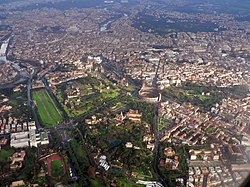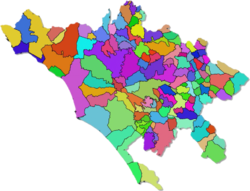Governorate of Rome (Kingdom of Italy)
Governorate of Rome
Governatorato di Roma | |
|---|---|
 Areal view of Rome | |
 Map of the Governorate of Rome | |
| Country | Italy |
| Established | 28 October 1925 |
| Capital(s) | Rome |
| Comuni | 1 |
| Government | |
| • Governor of Rome | Gianni Alemanno (PNF) |
| Area | |
| • Total | 5,363 km2 (2,071 sq mi) |
| Population (2017) | |
| • Total | 4,353,738 |
| • Density | 812/km2 (2,100/sq mi) |
| Time zone | UTC+1 (CET) |
| • Summer (DST) | UTC+2 (CEST) |
| ISTAT | 258 |
Governorate of Rome (Italian: Governatorato di Roma) is an area of local government merging levels of Administrative Region, Province and Municipality in the Kingdom of Italy. It comprises the territory of the city of Rome and 120 other settlements in the hinterland of the city. With more than 4.3 million inhabitants, it is the most populous Municipality and Province in Italy. It was established on 28 October 1925 by the terms of Royal Decree no. 1949.
Geography
The Governorate of Rome occupies the flat area of the Roman and the Tiber Valley to the mountains and dell'Aniene Lucretili Sabini and, in addition to the mountainous regions of the Tolfa and Monti Sabatini to the north-west, the area of the mountains Tiburtini Prenestini Simbruini and east, the area of the Colli Albani and the northern foothills of the mountains, and high Lepine Sacco valley to the south-east. The western boundary of the province is represented by the Tyrrhenian Sea on which spread to about 130 km from the coast near Rome from Civitavecchia to Torre Astura. In the territory there are several lakes, almost all of volcanic origin, which are concentrated in the north-west of the mountains and Sabatini in the south-east of the Colli Albani.
Administration
The Governorate of Rome is a highly centralized organization, reporting directly to the Chief of Government. The merging of multiple layers of authority allows to reconcile conflicts which hinder the development of the city. The Governorate of Rome is not a "city" in the usual sense of the term (i.e. a large continuous urban settlement), but instead an administrative unit comprising the Rome metropolitan area and its much larger surrounding rural area containing several minor settlements.
The Governorate of Rome is a first-level local state administrative organ. The Governorate of Rome is under the unified leadership of the Government of Italy, which has the power to decide on the division of power and functions between the Government itself and administrative organs of the Governorate. The Government also has the power to alter or annul decisions and orders made by the Governor of Rome. The Governorate of Rome implements laws and local regulations, are responsible for and report on its work to the Government. The Government has the power to supervise the work of the Governorate of Rome, change and annul inappropriate decisions and orders of the Governor.
The Governorate of Rome has the right to exercise unified leadership over the work of the Municipalities and exercise unified administration over the economic, social, and cultural affairs in areas under its jurisdiction.
Governor of Rome
The Governor is assisted by two Deputy Governors and supported by 10 Rectors. The Governor and Deputy Governors are officials of the State belong to the Administration of Interior: the Governor is a Prefect, 1st Class, while the Deputy Governors are Prefects, 2nd Class. In the figure of the Governor are centralized all powers of administration and representation of the Governorate as well as those of municipal companies which, however, he could exercise with the delegation system. However, despite being the Rome prefect, the Governor of Rome does not exercise security functions for the Urban Municipalities of Rome, but those are exclusively entrusted to the Quaestor, who reports directly to the Government.
The Governor is assisted by the Secretary General and is subjected to some of the controls exercised by the ministerial authorities.
The Governor of Rome is always an expression of Roman nobility and bound to the Party. The Ministry of the Interior does not have effective authority and freedom of action towards this particular institutional figure, which exercises its authority with irresponsibility, independence of resolution, which sometimes becomes arbitrary in contempt of the laws and regulations in force.
Rectorate
Rectors assist the Governor in establishing the organization of the different services and arrange for the study of issues or the preparation of projects to be submitted to the decisions of the Governor. The Governor, the Deputy Governors and Rectors collectively constitute the "Magistrate of Rome".
Council of Rome
The Governor of Rome is also supported by a Council of Rome (It: Consulta di Roma) with 80 Councillors (It: Consultori).
The Rome Council has advisory functions, although it may require confirmation of an Order by the Minister of the Interior with an absolute majority vote. The opinion of the Council can be delivered on the following topics: budget, taxes and enforcement of the relevant regulations, zoning, direct recruitment of public services.
Councillors are appointed by Decree of the Ministry of the Interior in consultation with the Ministry of Corporations, choosing from the triads proposed by the economic categories.
Municipalities of Rome
The territory of the Governorate of Rome is divided into 137 Municipalities (Municipalità; not to be confused with autonomous Comuni in other Provinces), as districts for participation and consultation. The municipalities are further subdivided into 355 urban areas, including for statistical purposes and land planning and management.
The Municipalities exercise the functions attributed to them by law, by the Articles of Association and by current regulations. Further functions can be conferred by decree of the Governor, after consultation with the Minister of the Interior. The Rectorate directs the Municipalities in the provision of the services attributed to them.
Municipalities represent their respective communities, represent their interests and promote their development within the administrative unit of the Governorate. The revision of the territorial delimitation of the Municipalities is decided by the Governor, after a non-binding vote of the Council. The name and the coat of arms of the Municipality are attributed by a decree of the Governor.
For serious reasons relating to the non-exercise of powers or services attributed to the Municipalities or non-implementation of directives, the Governor, after setting a peremptory deadline for doing so, entrusts the central bodies with the exercise of powers or the direct management of services and adopt the consequent initiatives.
Each Municipality has its own President, chosen by direct election, a Municipal Executive Committee, composed of six commissioners, including one with functions of vice-president, specially appointed by the President; Finally, each Municipality has a Municipal Council, composed of representatives of local Corporations. The Presidents of the Municipality meet in the Council of Presidents, a body supporting the Governor.
Functions
The Municipalities enjoy autonomy of management, their own financial and accounting procedures and have extensive powers, including those on local economic development and on private construction of local interest. For the performance of the tasks and functions within their competence, the Municipalities are assigned human, financial and instrumental resources, managed in compliance with the provisions of the law and regulations. Governor's decrees that transfer additional functions to Municipalities indicate the additional resources to meet them.
Municipalities manage:
- Demographic services;
- Social services and social assistance;
- School and educational facilities;
- Cultural, sporting and recreational activities and services in the local area;
- Urban maintenance activities and services, regulation of private building of local interest;
- Activities and services relating to the maintenance of green areas of local interest, with the exception of archaeological areas, parks and historic villas;
- Initiatives for economic development in the craft and trade sectors, with the exception of large-scale commercial distribution.
